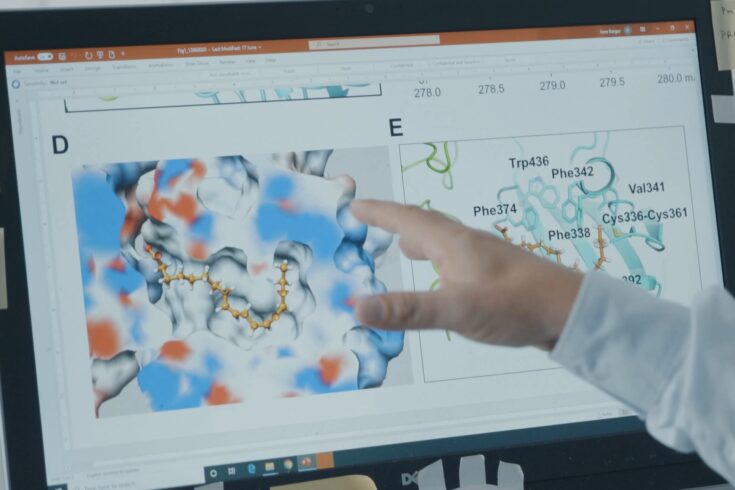An international team of scientists led by the University of Bristol and funded by UK Research and Innovation (UKRI) has found a feature of the SARS-CoV-2 virus that could be used to stop it from infecting human cells.
The druggable pocket in the SARS-CoV-2 Spike protein was discovered by an international team funded by the Biotechnology and Biological Sciences Research Council (BBSRC) and Engineering and Physical Sciences Research Council (EPSRC).
Potential ‘game changer’
Their findings, published in the journal Science on 21 September 2020 are a potential ‘game changer’ in defeating the current pandemic.
The team is headed by:
- Professor Christiane Schaffitzel, Academic Lead of the Wellcome Trust/BBSRC-funded GW4 Cryo-EM Facility at the University of Bristol
- Professor Imre Berger, Director of BrisSynBio, a BBSRC/EPSRC Research Centre for Synthetic Biology in Bristol.
It included experts from:
- Bristol UNCOVER Group
- Bristol biotech Imophoron Ltd
- Max Planck Institute for Biomedical Research in Heidelberg, Germany
- Geneva Biotech Sàrl, Switzerland.
The study was supported by funds from the Elizabeth Blackwell Institute with additional support from Oracle high-performance cloud computing and Genscript.
Their work was enabled by using the EPSRC-funded Archer supercomputer.
In this ground-breaking study they used a powerful imaging technique, electron cryo-microscopy (cryo-EM), to analyse SARS-CoV-2 Spike at near atomic resolution.
Their work could lead to small molecule anti-viral drugs being developed to target the pocket they discovered, which could help eliminate COVID-19 and stop virus in its tracks.
Peering deep inside virus
The surface of the coronavirus particle has proteins sticking out of it known as Spike proteins which are embedded in a membrane. They have the appearance of tiny little crowns, giving the virus its name ‘corona’. Inside the membrane is the viral genome wrapped up in other proteins.
The Spike plays an essential role in viral infectivity: it binds to the human cell surface, allowing the virus to penetrate the cells and start replicating, causing widespread damage.
A 3D structure of SARS CoV-2 Spike protein was generated using Oracle high-performance cloud computing, allowing the researchers to peer deep inside the Spike and identify its molecular composition.
Unexpectedly, the research team’s analysis revealed the presence of a small molecule, linoleic acid (LA), buried in a tailor-made pocket within the Spike protein.
What is LA?
LA is a free fatty acid, which is indispensable for many cellular functions. The human body cannot produce LA: instead, the body absorbs this essential molecule through diet.
Intriguingly, LA plays a vital role in inflammation and immune modulation, which are both key elements of COVID-19 disease progression. LA is also needed to maintain cell membranes in the lungs so that we can breathe properly.
Truly puzzled by the discovery
Professor Imre Berger, from the Max Planck-Bristol Centre for Minimal Biology, said:
We were truly puzzled by our discovery, and its implications. So here we have LA, a molecule which is at the centre of those functions that go haywire in COVID-19 patients, with terrible consequences.
And the virus that is causing all this chaos, according to our data, grabs and holds on to exactly this molecule – basically disarming much of the body’s defences.
Professor Schaffitzel, from Bristol’s School of Biochemistry, explained:
From other diseases we know that tinkering with LA metabolic pathways can trigger systemic inflammation, acute respiratory distress syndrome and pneumonia.
These pathologies are all observed in patients suffering from severe COVID-19. A recent study of COVID-19 patients showed markedly reduced LA levels in their sera.
Our discovery provides the first direct link between LA, COVID-19 pathological manifestations and the virus itself. The question now is how to turn this new knowledge against the virus itself and defeat the pandemic.
There is reason for hope
In rhinovirus, a virus causing the common cold, a similar pocket was exploited to develop potent small molecules that bound tightly to the pocket distorting the structure of the rhinovirus, stopping its infectivity.
These small molecules were successfully used as anti-viral drugs in human trials, defeating rhinovirus in the clinic. The Bristol team, based on their data, is optimistic that a similar strategy can now be pursued to develop small molecule anti-viral drugs against SARS-CoV-2.
Professor Schaffitzel added:
COVID-19 continues to cause widespread devastation and in the absence of a proven vaccine, it is vital that we also look at other ways to combat the disease.
If we look at HIV, after 30 years of research what worked in the end is a cocktail of small molecule anti-viral drugs that keeps the virus at bay.
Our discovery of a druggable pocket within the SARS-CoV-2 Spike protein could lead to new anti-viral drugs to shut down and eliminate the virus before it entered human cells, stopping it firmly in its tracks.
For UKRI, Executive Chair of BBSRC Professor Melanie Welham, said:
The COVID-19 pandemic has mobilised scientists all over the world to collaborate. Through curiosity-driven research we are discovering surprising things about this new virus.
The fascinating findings from this study – in part made possible through work with BrisSynBio, a BBSRC/EPSRC funded Synthetic Biology Research Centre, could be vital as we seek ways to control and defeat the virus.
Further information
A webinar explaining the team’s discovery of a druggable pocket in the SARS-CoV-2 Spike, is available on SelectScience.

